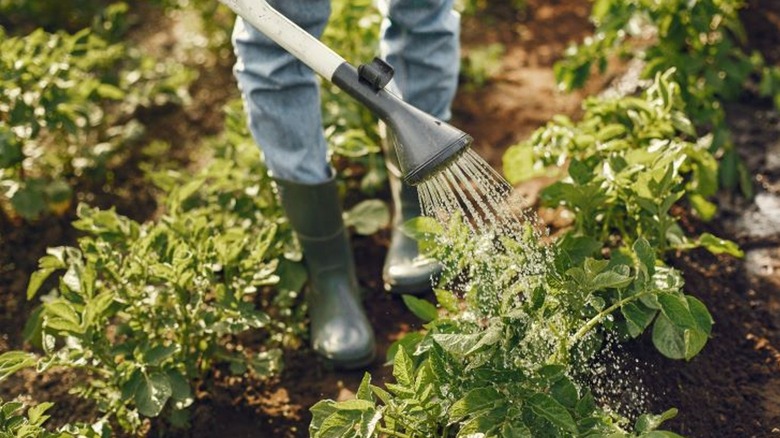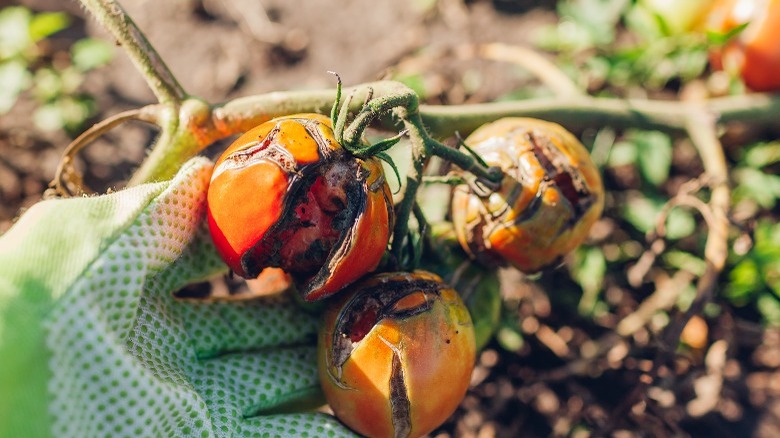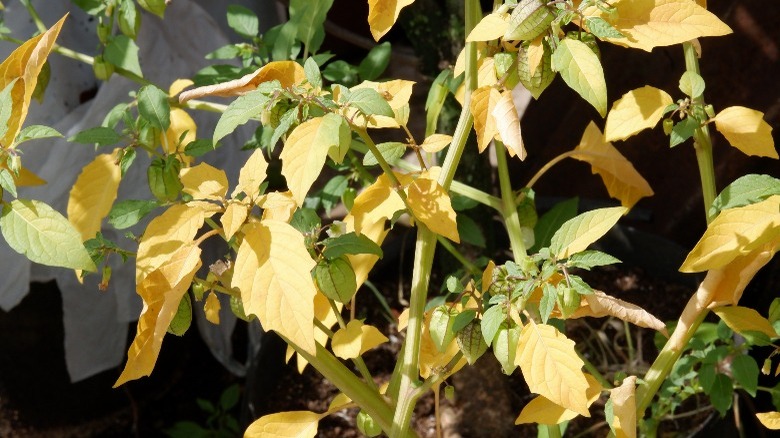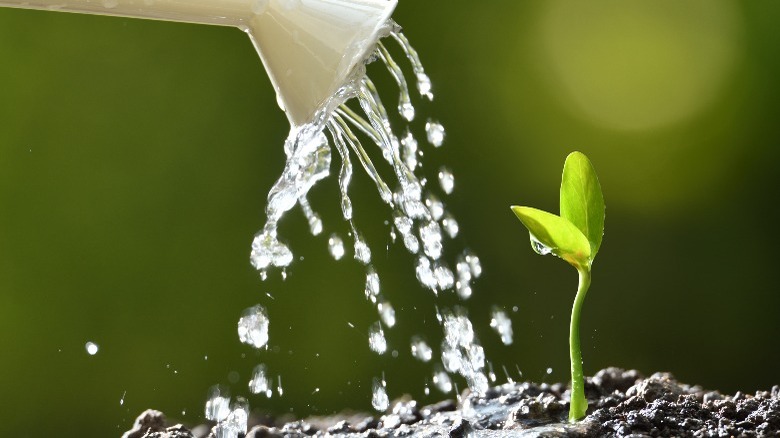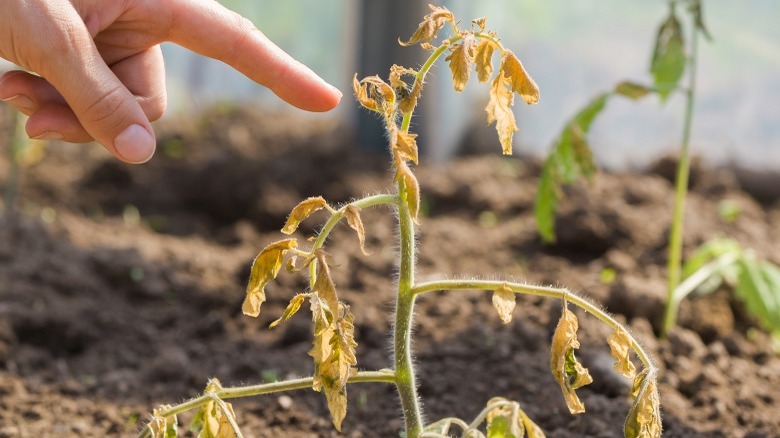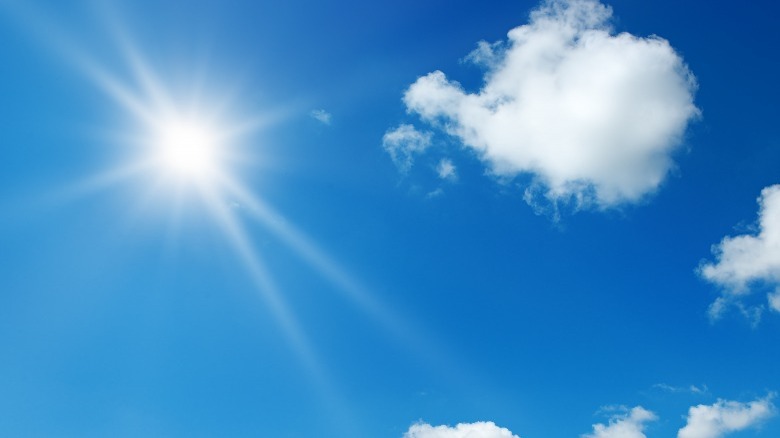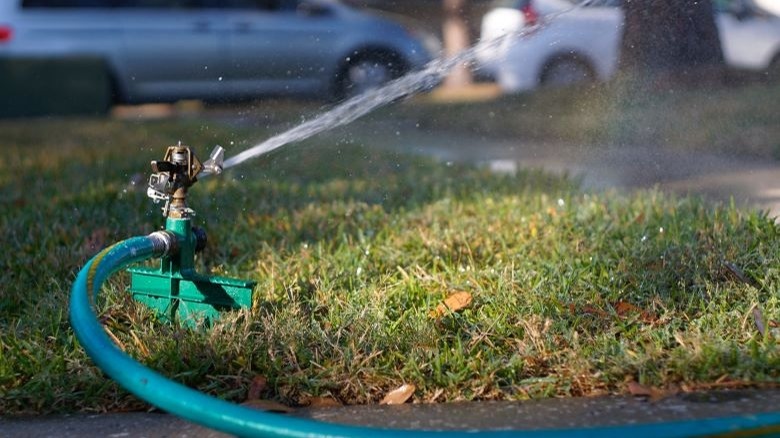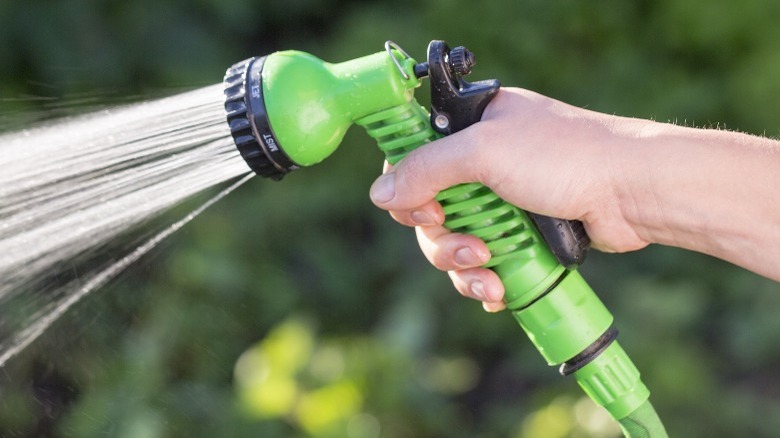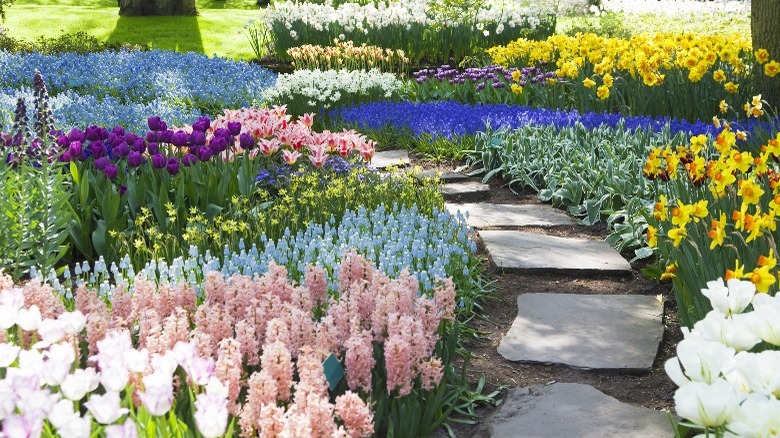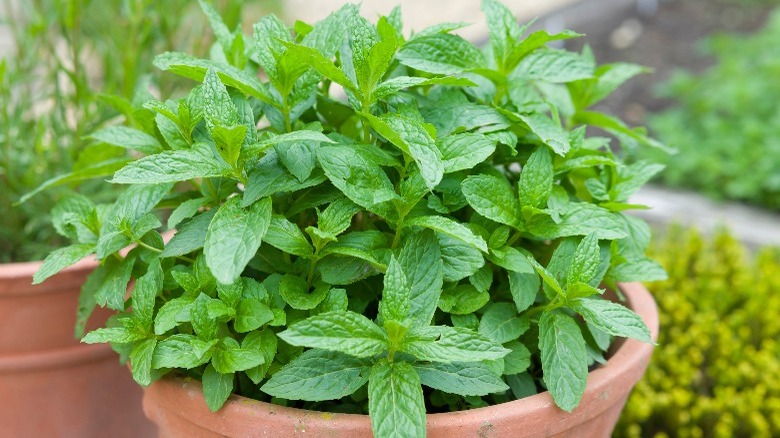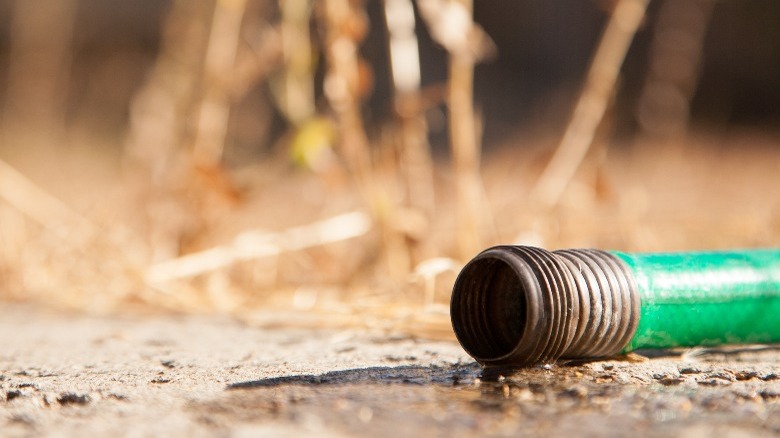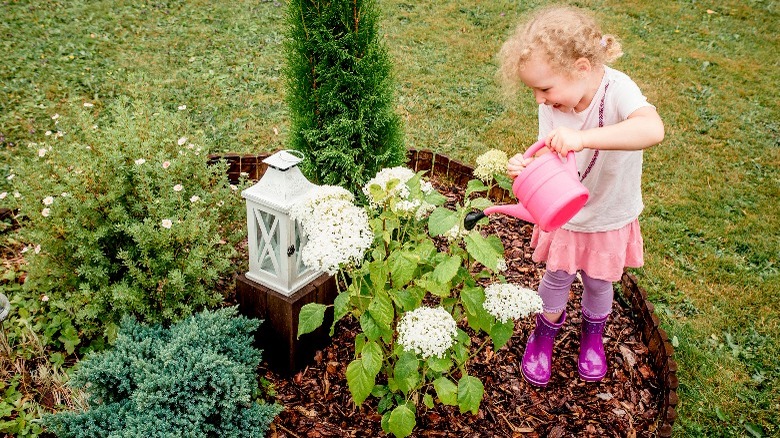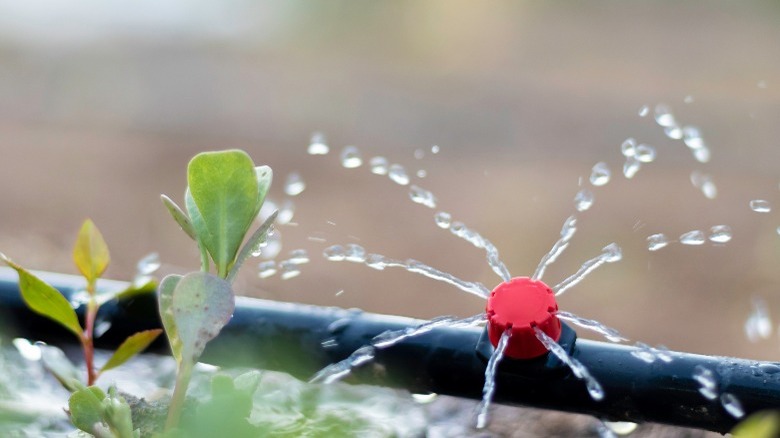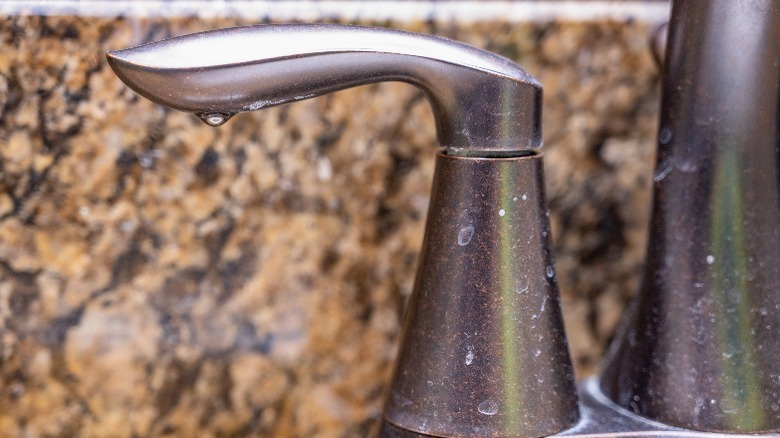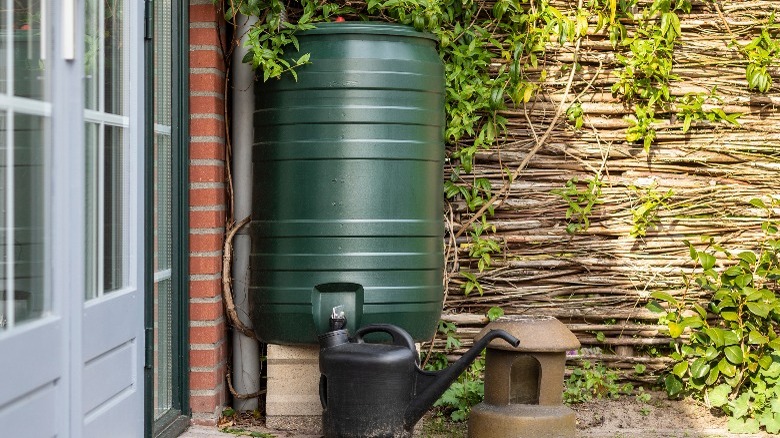Mistakes To Avoid When Watering Your Garden
Watering is crucial for healthy gardens, and things can go very wrong when certain mistakes are not avoided. If you're wondering why those plants aren't thriving, it is likely related to the amount of moisture getting drawn in from the soil. When plants are struggling, the chances for recovery are best when these mistakes are caught early. Switching to the right methods can save them, but weeks of neglect or just one shot of excessively high water pressure can kill them.
Watering mistakes lead to obvious symptoms, and it's best to check the garden frequently. Red flags include brown or yellowed leaves, mushy roots, curled leaves, wilting, and smelly soil. But don't start flooding the garden with water, or stop doing it altogether. Figure out the mistake and use the appropriate method to keep things well hydrated. Here's what could be the cause of your plant woes, and how to fix it.
Watering it too often
Overwatering is a common gardening mistake, and it's harmful because it minimizes the amount of crucial oxygen that plant roots need to survive. Although plants release carbon dioxide into the air, their cells use oxygen for aerobic respiration. This is part of photosynthesis and how plants release the energy that helps them grow.
Plants watered too often for prolonged periods don't get that needed oxygen, wilt and wither, and can develop fungus that leads to root rot; vegetables and fruits can crack and be inedible. These diseases present with spots ranging from yellow to black, ashiness, and dropped leaves. Plant fungus is difficult to cure, gets into the soil, and can spread to other nearby greenery. The rot is incurable, but sometimes plants can be dug up, and the affected parts can be cut away. Then, the roots could be replanted in new soil. This problem is more often seen in houseplants than gardens, but once the decay gets underway, the plant's chances for survival will be at risk.
Giving it too much water at once
Gardeners can also give garden plants too much water at one time, effectively drowning the roots and cutting off the oxygen supply. Suffocation can occur in mere minutes, and symptoms like heavily yellowed leaves can appear after a couple of hours. Too much water can also wash away that expensive fertilizer that was added to the soil.
If the garden soil seems dry at first glance, do some investigating before getting out the hose. Even if the surface seems parched, it might still be moist closer to the roots. Dig down a bit with a small shovel and check. However, young plants, shrubs, and trees must be treated differently because their initial watering needs are higher. They will benefit from deep watering at planting time.
Instead of overwatering gardens randomly, check the soil below the surface every two weeks. If it is dry, the deep watering method is the safest option. To do so, provide the garden with a gentle stream of water, slowly saturating it down to about 8 inches. Give it about an hour, and if puddles start forming on the top of the soil, turn it off.
Not targeting plant roots
Watering foliage might seem like the right move, but targeting the roots is safer and more efficient. It's a mistake to only direct the stream at stems, branches, and leaves because they are not equipped to absorb enough moisture for photosynthesis. Always direct the water down towards the garden soil, close to the bases of the plants. Expect the other parts to get wet from splatters, but that is of no concern unless it is excessive.
Plant leaves can be watered occasionally, especially when it's hot outside. In that kind of weather, the water will evaporate and provide a cooling effect. This can also spur the roots into pulling up more water from the soil. You also don't have to be afraid to give them a good spray to wash away an annoying Japanese beetle or hungry aphid, or to remove excessive dirt buildup. You just want to avoid soaking leaves and blooms with excessive and constant amounts of water since this could lead to mold growth.
Letting plants go thirsty for too long
It is hard to tell when a plant is being overwatered or underwatered because the symptoms are so similar. The key differences with a thirsty garden include thin and dropped leaves and dried-out soil. Overwatered soil, on the other hand, often has a distinct sour odor. Another way to tell is to water the plants a small amount. If they perk up a bit, they are in dire need of moisture.
Gardens succumb to the effects of underwatering during droughts. They can also experience it when their owners are away from home for prolonged periods or are too busy to stay consistent. Fast-draining soil and seasonal changes can also increase the need to water a garden more often. Fortunately, underwatered garden plants generally respond to watering within a day unless they have little or no life left in them. However, it can take up to three months to produce new growth and six months to recover fully.
Watering it when it is too sunny outside
A hot, bright sun might make you think that it's time to water the garden, but this is the wrong time to do so. That's because the strong rays and heat make water evaporate before it has time to get to the roots. Gardeners who make this mistake also end up wasting a lot of water. Watering the garden in the afternoon sun can also cause leaves to burn.
So instead of watering the garden at that peak time of day, opt for the early morning or evening when it isn't dark out. Cooler temperatures earlier in the day allow for better absorption and give the foliage enough time to dry out before nightfall. It also provides the plants with enough moisture to withstand the drying effects of daytime heat. And while evening watering is somewhat better than doing it in the sunshine, the water is more likely to accumulate on the foliage and around the roots.
Using a lawn sprinkler
It's not unusual for people to use lawn sprinklers for their gardens, but this can also be a mistake. An oscillating sprinkler connected to a hose has water-spraying holes that spurt the water in different directions. They are mostly used for wide open areas, broadcasting the water droplets over grass. These kinds of sprinklers don't direct water to plant roots and can make leaves overly wet. Their fan-like water distribution patterns are great for new grass seeds, but not gardens.
Powerful lawn impact sprinklers are also not designed for this purpose. They can be set up to target certain areas but have hammers inside their sprinkler heads that create strong water pressure. Picture that getting sprayed onto a tender young plant, and you can see why this is a big no-no. Another problem with using lawn sprinklers in gardens is the tendency for the water to evaporate before landing. This is more likely to happen on breezy and steamy days.
Using a powerful nozzle on a garden hose
Outdoor hoses can be used for gardens as long as they have the right kind of attachment. If the wrong one is used, the garden will suffer. Avoid using jet-type spray nozzles because they will cause damage when the wrong setting is used. Even if the nozzle has different ones with less pressure, there's always the chance of using an inappropriate setting by mistake. It can kick up the soil or rip off blooms. However, on the opposite side of the spectrum, a wide spray won't penetrate deep enough into the dirt. Instead, it will just mist the plants.
Slim watering wands are well-suited for gardens and are easy to use. They get attached to garden hose ends just like nozzles and are easier on the back. They extend up, out, or down, allowing users to target the water where needed. You won't have to get down on your knees or stretch out uncomfortably or painfully to get to those plants at the back, either.
Not realizing that plants have different watering needs
It's never a good idea to go ahead and water an entire garden without considering the individual residents. While it's easy to get into an unchanging garden watering routine, plants have different moisture needs, so one size does not fit all. Age is an important factor, as newly-planted and younger ones need more water than their older counterparts. Their roots are still developing and need more nutrients during this crucial phase. Mature plants will benefit from less frequent, deep watering.
The smartest way to water plants in this respect is to understand their individual needs. Some have to be watered more often, while others are more drought-tolerant. Succulents thrive in dry conditions and don't need as much attention, while prolific flower producers like hydrangeas require more. So when planning a garden, plant everything in groups according to how often they need to be watered. This takes out the guesswork and makes the job much easier.
Not watering container garden plants often enough
Container gardening caught on because pre-planted containers are ready to go, easy on the eyes, and can be brought inside when the weather isn't cooperating. But there's one important caveat: They need to be watered more often than plants in the ground. Their soil dries out faster, which happens even more quickly with smaller pots. The culprit here is the peat moss contained in many potting soils. Even though it retains water, it can dry out to the point of blocking water absorption. And if the container has drainage holes, the water will be exiting sooner than later.
Outdoor garden container plants must be watered once daily unless it rains. And if the temperature is excessively high, check it in the afternoon and water again if needed. Do this with a hose trickling out water, but when that can't be done, opt for an automatic spike plant waterer. Or, if the pot is small enough, place it in a shallow container of water for about an hour.
Getting the temperature wrong
Plants prefer warm water with a temperature of about 68 degrees Fahrenheit. This gets the roots going for optimal water and nutrient absorption and allows them to take in more oxygen. Frigid water can lead to deadly root shock, and if it's too hot, there can be burnt leaves and tissue damage.
Problems can arise when hoses are left out in the heat or cold for too long; in some cases, this can even be dangerous. Any residual water inside the hose could get superheated, creating boiling water. Always store them correctly when they're not being used to avoid these mistakes. If the water seems icy cold, unwind the hose and leave it in the sun for a little while before watering. You can also pour it into a watering can and let it become room temperature. It's also possible to hook it up to a kitchen, bathroom, or laundry room sink using an adapter. However, that can be awkward if the sink isn't near a window or exterior door, and the hose has to travel through the house. The good news is that as long as the water stays above 50 degrees, there shouldn't be a problem.
Watering mulched areas as often as non-mulched areas
Experienced gardeners constantly sing mulch's praises, recommending it for protecting soil and preserving water. Gardens benefit from it, but mulched areas must be watered differently than non-mulched ones. The most popular kinds include lawn clippings, shredded bark, and compost. They get layered right on top of the soil and act as barriers that hold in moisture. This means that the soil stays damper for longer, allowing you to water plants up to two-thirds less as often.
Since this barrier prevents evaporation, the hose won't need to be used as often. You may need to dig through material to see how dry the soil beneath is, but that's nothing compared to the amount of time saved from frequently watering the garden. Mulch doesn't last forever, though, and loses its water retention properties over time as it decomposes. That means you might need to increase the amount of water those plants need, so keep an eye on its freshness.
Refusing to consider drip irrigation and soaker hoses
Drip irrigation and soaker hoses might seem intimidating to novice gardeners but they are easy-to-use, effective watering tools. The moisture penetrates the roots and comes out slowly and consistently instead of sporadically. And since they are placed close to the soil, the moisture gets directed right where it needs to go. Just like mulching, these setups take time to put in place, but after that, there's not much work to do, and the benefits are worth it.
Soaker hoses look like regular hoses but have small holes throughout their lengths. They should be placed on flat ground and can only be configured in certain ways. The pressure is the same throughout the hose and can't be adjusted for certain plants. Drip irrigation systems can be expensive but are more versatile. They're easy to install and can be laid out in different paths. They can provide variable water pressures and also work well on sloped gardens.
Using poor-quality tap water
If your tap water isn't safe for drinking, it might be harming your garden. While it's usually okay to use, it could contain high levels of unwanted substances. One is fluoride, which may halt photosynthesis. Too much of it can lead to fluoride toxicity, which shows up in yellowing leaf tips that turn brown. Another offender is chlorine; too much damages roots.
Tap water always has calcium and magnesium, but high amounts can hurt roots and change soil pH. Hard water in the soil can prevent plants from absorbing moisture — look for wilting, dry leaves, and salt deposits on the foliage and dirt. Signs of high levels in the house include hard water spots on faucets.
If you think your tap water isn't healthy enough for your garden, request a report from the local water authority or a testing company. Don't water your plants with harmful minerals– distilled or filtered water can solve the problem.
Not taking advantage of free rainwater
Rainwater is another option to try when the local supply isn't safe. It can also save a lot of money because there are no costs once a system is set up. Rain barrels can be purchased at Lowe's and other home supply outlets, and the capacities range from 50 to 100+ gallons. To set up the system, place a base made of bricks or another solid material on a level area next to a home gutter downspout. Put the empty barrel on the base and measure out and mark a location on the spout that's right above the barrel. That gets cut off with a hacksaw, but save the piece to reattach when the barrel isn't used.
Then, attach a flexible hose to the spout and direct it towards the barrel. When the rain barrel is full, look for its overflow valve, remove the opening, and attach a spigot or hose. Rain barrels have filters, so you don't have to worry about debris and other things getting into the usable water. However, it's best not to use rainwater collected via gutters in vegetable gardens, though, because chemicals from some roof shingles can get into the barrel.
